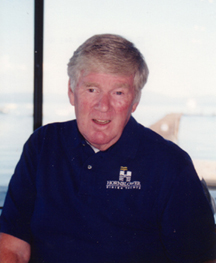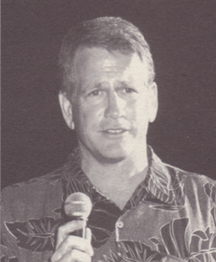Roger Murphy, who founded the Blue and Gold Fleet and was a major figure in the revival of ferry operations on San Francisco Bay, died of heart failure on the last day of March.

By Carl Nolte
Published: May, 2001
Roger Murphy, who founded the Blue and Gold Fleet and was a major figure in the revival of ferry operations on San Francisco Bay, died of heart failure on the last day of March.
"Roger Murphy was a father figure of the ferry fleet," said Bobby Winson, the editor of Bay Crossings, who knew Murphy well. "He was not only a ferry operator and manager, but a mentor to many of his deckhands and other workers, particularly to African Americans and women, whom he encouraged to take the Coast Guard exams so they could become ferry captains".
"He encouraged people to reach their full potential in an industry he loved," said Captain Sandra "Pip" Elles, who started as a deckhand when the Blue and Gold company was new and is now a Blue and Gold vice president. She said that nearly all of Blue and Gold’s ferry skippers came up from deckhand jobs. "Roger always said that people who knew the business from the ground up made the best captains, and he always thought his captains were the best on the bay," said Judy Murphy, Roger’s widow.
Roger Murphy was a member of an old Bay Area family that came to California in pioneer days. For many years, the family business was the Murphy Pacific company, which built bridges.
Among the company’s bridges were the San Mateo bridge, the Richmond-San Rafael Bridge and the Martinez bridge. Roger joined the family business in 1959 when he graduated from St. Mary’s College and later the company went into the tugboat business.
Their biggest competition was the old Red Stack Company, owned by the Crowley interests. Murphy tugs lost a long battle on the bay with Crowley but won an anti-trust case in court later.
Murphy tugs put up a gallant fight against the bigger and stronger Crowley outfit. But Red Stack, which was a legend on the bay, was much too tough. The Murphy’s later claimed that Red Stack had used unfair business practices; the competition was not a fair fight. Murphy Tug sued in court and won an antirust case. It was a famous victory: Murphy won, but got no money. So, in effect, he lost.
Not long afterward, Roger Murphy launched the Blue and Gold fleet with three boats and took on the Crowley interests again. He was an early advocate of ferry operations, and famously said in 1989 that within ten years the bay would be covered with ferryboats. He was right.
The Blue and Gold fleet was financed by the interests who owned Pier 39; later they acquired most of the assets of Crowley’s Red and White fleet. Blue and Gold operates ferries to Alcatraz, Oakland, Alameda, Tiburon, Sausalito and Vallejo.
The Blue and Gold fleet years were in many ways, Roger’s best. He knew how to run boats, and he had fun doing it. Nearly all the passengers knew Roger. He took a personal interest in them and in the service. To Murphy, passengers weren’t just human freight; they were people who appreciated good service.
Roger also took an interest in his crews. They were like family to him, and he wanted them to get ahead. Since he was also a sports fan—basketball was his sport—he gave summer jobs to St. Mary’s and UC Berkeley basketball players.. The Cal players, at least, fit right into Blue and Gold’s theme. The first three boats were named Oski, Golden Bear and Old Blue, and the rival Crowley boats, were the Red and White fleet. It was no coincidence that Roger’s boats were painted Cal colors and Crowley’s the colors of the hated Stanford Cardinal.
His true love, however, was St. Mary’s. In college, he had been a member of the rally committee and he had an encyclopedic knowledge of the lore of the Galloping Gaels. He loved sports—the Bears and the Gaels—in equal measure with life on the water. That was one of the things that made him such a delight to know. In many ways, he had the look of a big bear and the enthusiasm of a big kid.
Roger Murphy left Blue and Gold a few years ago and for a time ran tour boats on Lake Tahoe. In 1998, he and some partners made an unsuccessful bid to take over the Alameda-Oakland ferry. More recently, he worked as a consultant.
Roger Murphy was 66 when he died. He1 left behind four sons and a daughter. Two of his sons—Roger Murphy Jr.—called "Skip" by his friends, and Patrick Murphy, are ferry captains.
Carl Nolte works at the San Francisco Chronicle and is a hell of a guy.
Jim Brecht 1952-2001
A memorial service was held April 12 at Santa Rosa’s Luther Burbank Center for the Arts for Jim Brecht, the developer who had been leading efforts to bring ferry service to Port Sonoma who died unexpectedly in April. An overflow audience of more than 1,000 attended.
Jim Brecht was president of Simons & Brecht Inc., Sonoma County’s preeminent real estate investment and development company, with development projects including the FountainGrove Inn, Stony Point Office Park and Northpoint/Corporate Center. The firm has designed and built over 2 million square feet of commercial property over the last thirty years and has been recognized with over 50 awards for excellence in Environmental, Design and Community enhancement.
Mr. Brecht’s commitment to the Sonoma County community extended to an active involvement in economic development and tourism promotion. He served as co-chair of the Santa Rosa Food-Wine committee, a Design Team Member of the County Vision Project, and Chair of the Economic Development Division of the Chamber of Commerce. He had a special passion for reviving rail service to downtown Santa Rosa and worked tirelessly to bring a farmer’s market and wine education center to the site of the historic Santa Rosa railroad station. He was a good man, great backer of the vision for a regional ferry service and will be sorely missed.

Jim Brecht 1952-2001

